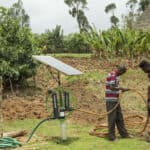From Talk to Action: The Pressing Need for a Guiding Framework in Impact Investing
The movement toward investment that targets a social and/or environmental impact is gaining momentum across the globe – especially in emerging and frontier markets. In sub-Saharan Africa in particular, impact finance has been pivotal in unlocking a new source of capital to balance the shortage of state funding for impact-oriented initiatives. The visibility of these efforts has been amplified by ambitious commitments like the Sustainable Development Goals. This momentum has shown the difference private sector engagement can make when mobilized for social impact.
But as the sector looks toward the next stage of its evolution, the need for some common principles has become clear. Questions have emerged about what impact investing is – and what it isn’t – as well as how the social impact of these investments should be measured.
To help answer these questions, 40 thought leaders converged in Austria last month, under the aegis of the Alpbach Forum, in an effort to develop a framework that would guide the impact investing space going forward. The forum represented an important step in the conversation about the meaning and ongoing evolution of the sector. From our perspective at StratLink Africa Ltd, a Nairobi-based financial advisory firm focusing on emerging and frontier markets, the discussion of a guiding framework for social impact finance could not have been more timely – particularly for investors in sub-Saharan Africa.
Making investors more rigorous in measuring impact
For one real world example, one needs only to look at mobile phone-based microcredit solutions, which have gained traction in markets such as Kenya. With these products increasingly targeted at the largely uncollateralized informal segment of the economy, microcredit lenders have been seen as dovetailing seamlessly with the wider financial inclusion narrative. As such, these lenders have evolved into one of the first ports of call for impact-focused investors seeking investible companies in the country.
But while this capital-raising tide has been building, concerns have grown over unfavourable lending practices, characterised by the usurious interest rates and short loan repayment periods pervasive in the sector. If the findings of a 2017 study by Financial Sector Deepening Kenya are anything to go by, these concerns are often valid. The survey revealed that 26 percent of mobile phone microcredit borrowers in Kenya felt loan repayment periods were too short, 12 percent reported encountering unexpected fees, and 10 percent felt the cost was too high. Viewed against this backdrop, the quality of the social impact made by mobile phone-based microcredit lenders is increasingly eliciting more questions than answers – even as companies in this space remain on investors’ radar for viable capital injection.
This is an area that could perhaps benefit from a guiding framework – one that spells out the requirements that ought to be met to qualify a company as investible within the paradigm of impact finance. Granted, various impact-focused funds and their respective investment committees have their decisions screened through an environmental, social and governance (ESG) framework. But the ESG framework, though useful, fails to incorporate certain elements which are deemed pivotal in impact assessment. One good example is the subject of human rights. Another is the question of how much incomes should increase over time, to not only allow individuals/households to have disposable income, but more importantly to cushion their standard of living from the erosion of inflation.
There is reason to believe that a more broadly accepted framework would be a step in the right direction for players in the impact finance ecosystem. In the same way that the Basel Accords have standardised assessment of risk in the banking and finance sector across the globe, distilling various impact assessment frameworks into one all-encompassing framework would ensure a common perception of risk and return in impact finance. A harmonized framework would also provide a vital link between the Sustainable Development Goals, which have been established as the macro level guide for impact across the globe, and businesses operating within the impact space at a micro level.
Enhancing the visibility of potential investee companies
Repeat capital raising by select businesses has emerged as a common trait of the impact finance landscape in countries like Kenya. While it is not unusual for investors to cherry pick, this has ended up causing the impression of a supply-demand disequilibrium, with high-appetite investor capital meeting disproportionately few investible companies.
We appreciate that the development of a robust pipeline of investible companies can be challenging in frontier markets. However, this trend could also reflect the reduced visibility of eligible companies, due to a lack of (or insufficient knowledge of) the risk-return-impact paradigm that is used by investors in informing decisions. Coupled with aggressive publicity, a harmonised framework could play an instrumental role in enhancing awareness of the eligibility criteria for impact investing, and perhaps widen the pool of investible companies beyond the traditional favourites. For companies involved in sectors whose appeal is undermined by perceived high risk, a harmonized framework could present useful guidelines on how to package themselves to potential investors.
Beyond Alpbach: What’s next?
The conversation on a possible framework for impact finance neither started nor ended at the Alpbach Forum. But the forum did provide an additional voice to the push for a convergence point, at a time when the impact finance space is cluttered with multiple assessment frameworks – many of which are pulling in different directions.
Beyond the forum, participants of the event have structured ongoing working groups aimed at fleshing out the details of various pillars of a unified framework. The goal is to decentralize the conversation from the conference, to make a more meaningful impact where it matters most, across countries. This could include establishing underlying principles and standard impact measurement practices, and ensuring country-level engagement, with a view to ensuring that this conversation is focused less on high-level conferences and more on localized approaches.
As for the long-term horizon, the Alpbach Forum’s tool kit of next steps includes consideration of a standards and certification body. This would make it much easier to bring visibility to many potential investee companies which, at the moment, can only be found through due diligence assessment by investors. What is critically important at this juncture is for stakeholders in the impact investing ecosystem to reach that elusive inflection point where the clamour for a common framework leads to the actual adoption of one. In an environment where “impact washing” is increasingly threatening to weaken this critical pillar of development finance, the urgent need for a common framework cannot be overstated.
Julians Amboko is a senior research analyst with StratLink Africa
Julio De Souza is the director of SME and Impact Finance at StratLink.
Image courtesy of Dmitri Popov.
- Categories
- Investing



